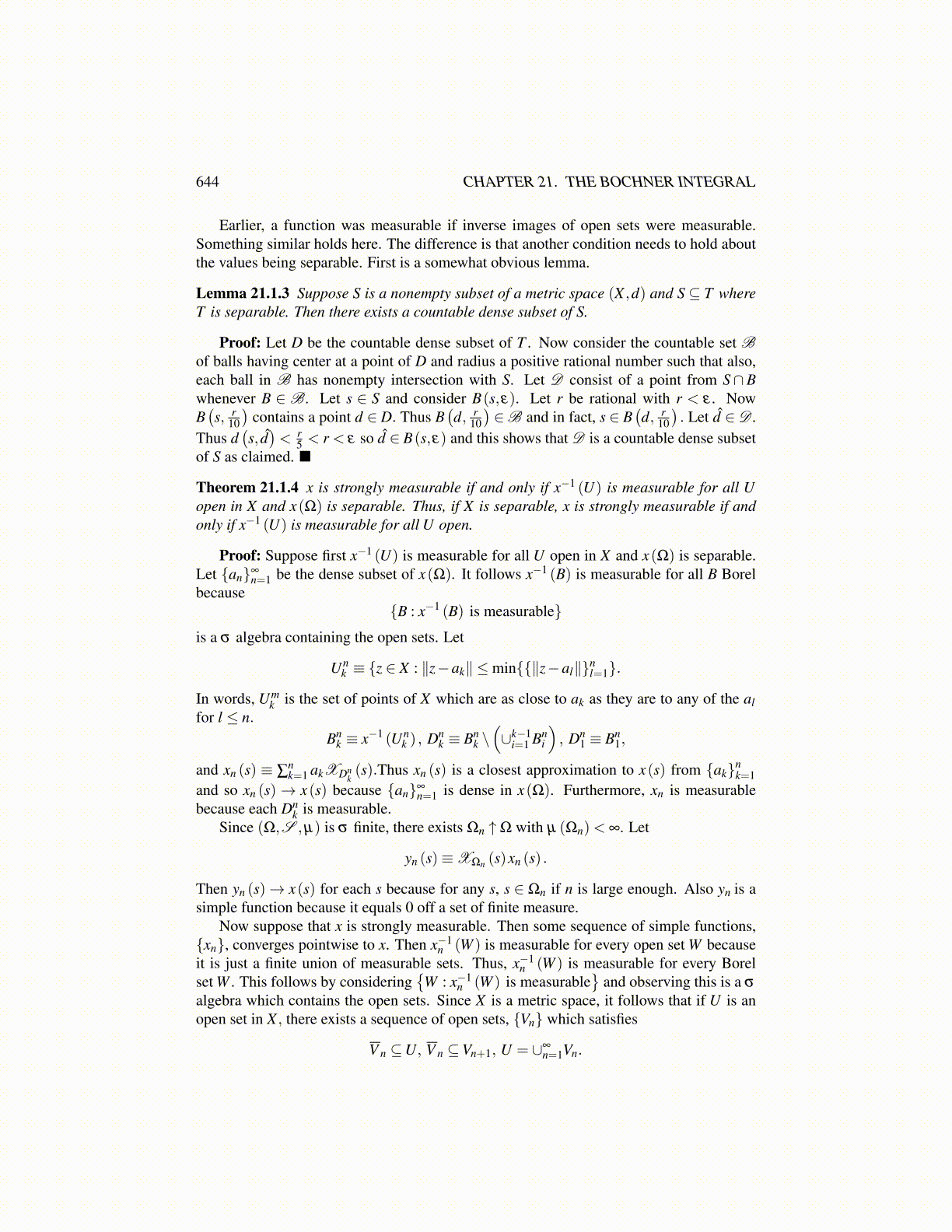
644 CHAPTER 21. THE BOCHNER INTEGRAL
Earlier, a function was measurable if inverse images of open sets were measurable.Something similar holds here. The difference is that another condition needs to hold aboutthe values being separable. First is a somewhat obvious lemma.
Lemma 21.1.3 Suppose S is a nonempty subset of a metric space (X ,d) and S ⊆ T whereT is separable. Then there exists a countable dense subset of S.
Proof: Let D be the countable dense subset of T . Now consider the countable set Bof balls having center at a point of D and radius a positive rational number such that also,each ball in B has nonempty intersection with S. Let D consist of a point from S∩Bwhenever B ∈ B. Let s ∈ S and consider B(s,ε). Let r be rational with r < ε . NowB(s, r
10
)contains a point d ∈ D. Thus B
(d, r
10
)∈B and in fact, s ∈ B
(d, r
10
). Let d̂ ∈D .
Thus d(s, d̂)< r
5 < r < ε so d̂ ∈ B(s,ε) and this shows that D is a countable dense subsetof S as claimed.
Theorem 21.1.4 x is strongly measurable if and only if x−1 (U) is measurable for all Uopen in X and x(Ω) is separable. Thus, if X is separable, x is strongly measurable if andonly if x−1 (U) is measurable for all U open.
Proof: Suppose first x−1 (U) is measurable for all U open in X and x(Ω) is separable.Let {an}∞
n=1 be the dense subset of x(Ω). It follows x−1 (B) is measurable for all B Borelbecause
{B : x−1 (B) is measurable}is a σ algebra containing the open sets. Let
Unk ≡ {z ∈ X : ∥z−ak∥ ≤min{{∥z−al∥}n
l=1}.
In words, Umk is the set of points of X which are as close to ak as they are to any of the al
for l ≤ n.Bn
k ≡ x−1 (Unk ) , Dn
k ≡ Bnk \(∪k−1
i=1 Bni
), Dn
1 ≡ Bn1,
and xn (s) ≡ ∑nk=1 akXDn
k(s).Thus xn (s) is a closest approximation to x(s) from {ak}n
k=1and so xn (s)→ x(s) because {an}∞
n=1 is dense in x(Ω). Furthermore, xn is measurablebecause each Dn
k is measurable.Since (Ω,S ,µ) is σ finite, there exists Ωn ↑Ω with µ (Ωn)< ∞. Let
yn (s)≡XΩn (s)xn (s) .
Then yn (s)→ x(s) for each s because for any s, s ∈ Ωn if n is large enough. Also yn is asimple function because it equals 0 off a set of finite measure.
Now suppose that x is strongly measurable. Then some sequence of simple functions,{xn}, converges pointwise to x. Then x−1
n (W ) is measurable for every open set W becauseit is just a finite union of measurable sets. Thus, x−1
n (W ) is measurable for every Borelset W . This follows by considering
{W : x−1
n (W ) is measurable}
and observing this is a σ
algebra which contains the open sets. Since X is a metric space, it follows that if U is anopen set in X , there exists a sequence of open sets, {Vn} which satisfies
V n ⊆U, V n ⊆Vn+1, U = ∪∞n=1Vn.